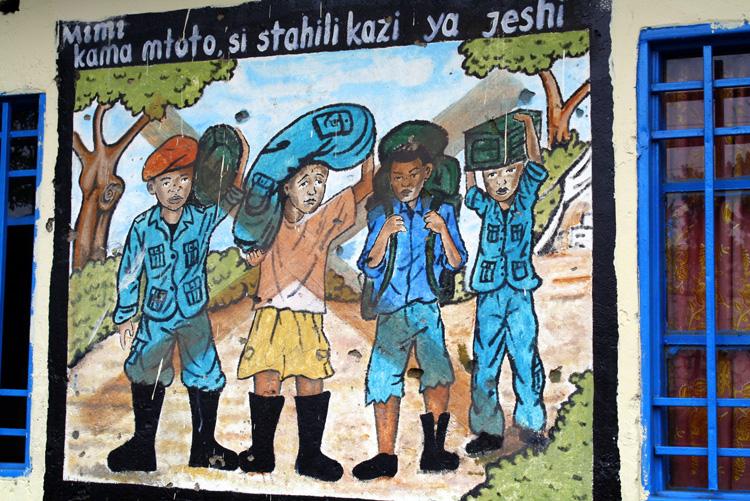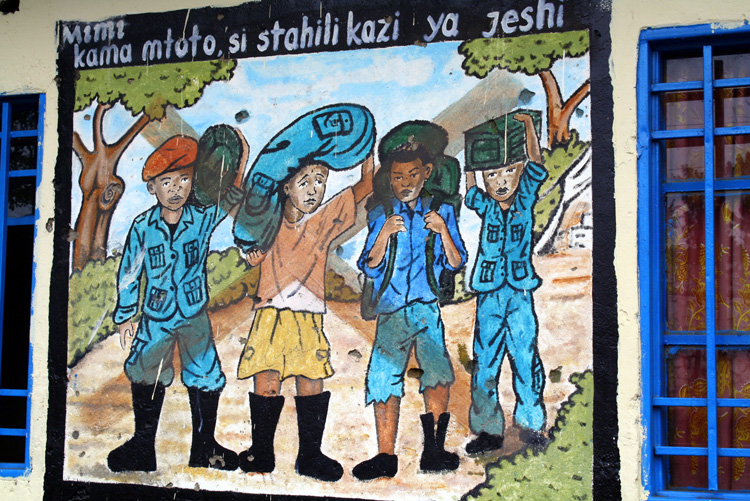Children in eastern Democratic Republic of the Congo (DRC) face increasing danger of being recruited as soldiers by more than twenty armed groups fighting in and near the city of Goma, capital of North Kivu Province.
The M23 rebel group that occupied Goma last week indicated Wednesday that it may start withdrawing from Goma, meeting conditions to start negotiations. A humanitarian crisis remains imminent in the region warn advocacy groups, as more than 100,000 people have been displaced in the rebels’ conflict with the Congolese army.
More than half of the displaced people are younger than 18 years old, according to UNICEF. World Vision estimates there are 200,000 children in Goma, and believes they are all at risk.
Displaced children are highly likely to be recruited—forcibly or by choice—by M23.
“When displacement happens, children lose sight of their parents. This is one of our biggest concerns,” said Alessandra Dentice, chief of Child Protection at UNICEF in Kinshasa. She is currently working with about 3,000 children recruited by armed groups across the country.
The UK-based organization SOS Children reported that 1 in 10 of the world’s child soldiers are found in the DRC—that is a total of about 30,000 child soldiers in the DRC. SOS also found that 15–30 percent of all newly recruited combatants in the DRC army are younger than 18 years old.
Children Seeking Stability in Displacement
Dentice explained how child soldier recruitment works in the DRC.
When children are on the move with their parents during displacement, they do not go to school, and they are often left unattended.
These are prime conditions for forcible abduction. Some children also join armed groups voluntarily. In their idleness, the idea of combat can seem exciting. Seeing their parents struggle, they may be lured by offers of payment. They may also wish to contribute to their community by fighting for an issue.
While in the ranks of armed groups, children are used as fighters, porters, sex slaves, and cooks. According to the Internal Displacement Monitoring Center girls represent almost 50 percent of children abducted by the militant group Lord’s Resistance Army (LRA) in the DRC in 2009.
But after spending time with armed forces and being disillusioned by the cruel reality of war, children hurry to return to normal life.
Unfortunately, even if they are able to return home, some children no longer have a place there.
“We want to make sure these children are not discriminated against and stigmatized just because for a moment in their life they have been made to commit horrible things,” said Dentice.
War Child reports that some families do not accept their returning children because of the violence and killing they took part in. Other families do not want the children at home to protect them from being attacked by other members of the community.
Reintegrating Former Child Soldiers
Dentice says that some children either escape or are included in the process for demobilization. First, they are taken to a child protection agency. They are then given temporary care in a transit center or in host families across DRC, and child protection agencies trace the family of each child.
When the family is found, the child is reintegrated back to his or her family, with a package for support which includes education, professional training, medical support, and psycho-social counseling.
“It is a difficult situation [for these children], there is trauma hard to overcome,” said Dentice. “These are children who, for a period of their life, are not children any longer: they have been forced to use arms, live in very hard conditions, and see scenes they should not have seen. Instead of going to school or playing with other children they are armed and are told to fight.”
Alaine Lapierre from CARE Canada, says that the process of demobilization and advocacy for releasing children from the claws of armed groups takes years—but it is well worth it.
“The most satisfying thing is to get back to the village where children were reintegrated and to see them feel very well. Then we know we have achieved our goal.”
Lapierre has been involved in rescuing and follow-up observation of at least 500 children in Chad between 2007 and 2012.
UNICEF has also helped 100,000 children in 15 countries go back to their families since 1998. In 2010 alone, UNICEF helped 11,400 children formerly associated with armed forces and armed groups along with 28,000 other vulnerable children in conflict areas.
The Epoch Times publishes in 35 countries and in 19 languages. Subscribe to our e-newsletter.







